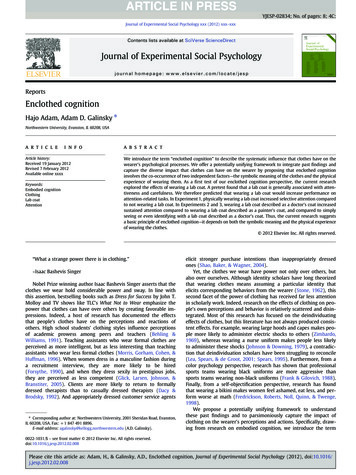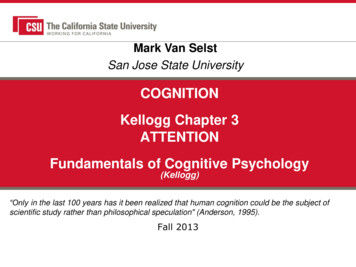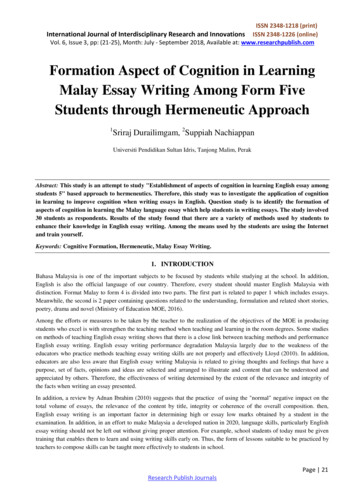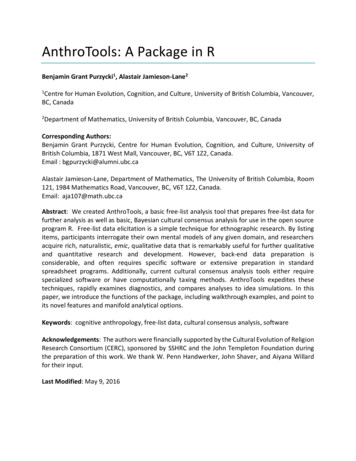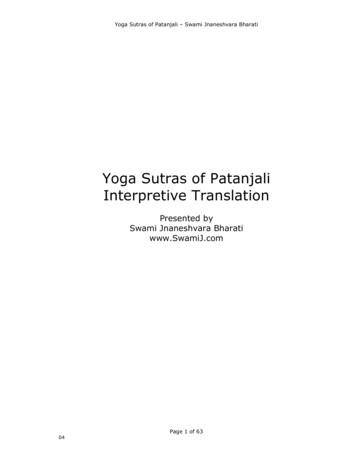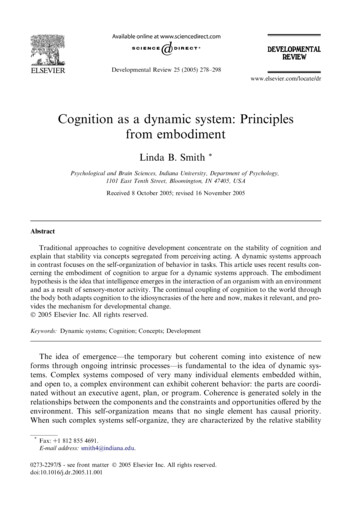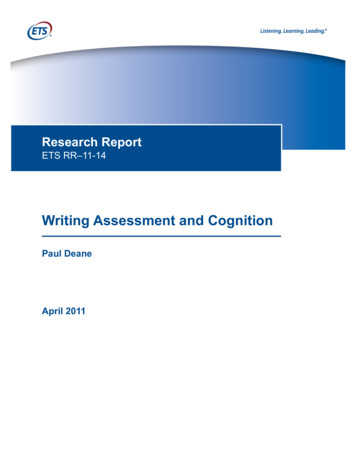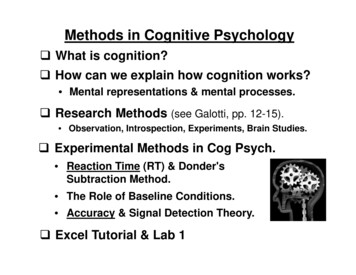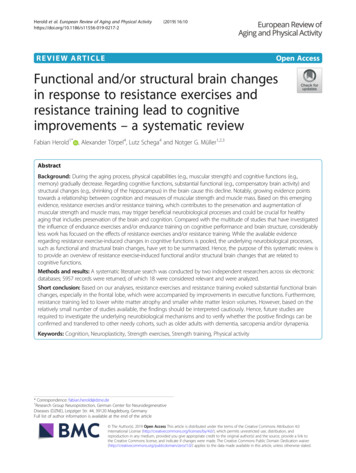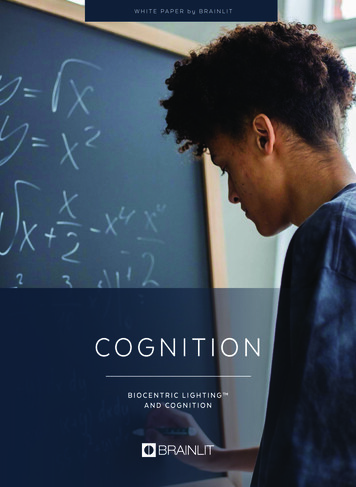
Transcription
W H I T E PA P E R b y B RA I N L I TCOGNITIONBIOCENTRIC LIGHTING AND COGNITION
W H I T E PA P E R b y B RA I N L I TB I O C E N T R I C L I G H T I N G TMAND COGNITIONCognition describes higher-level mental processes, such as problem-solving, thinking, attention, memory, and learning. Maintaining a high level of cognitive performance is essential in many fields of work, in education, while driving, and forother day-to-day tasks. Cognition can be assessed through a variety of tests aimed at evaluating attention, reaction times, or working memory amongst others.Several scientific studies point to a role of light, especially blue or blue-enrichedwhite light, in modifying and improving the timing and level of cognitive performance.Light improves cognitive performanceMany of us experience dips at some pointthroughout the workday with lower levels ofalertness and attention to the task at hand. Itis common to use strategies to help maintaincognitive performance during these dips suchas drinking coffee, taking an afternoon nap,or going for a short walk. The lighting of ourenvironment is another element to consider,as light has been shown to influence ourcognitive processes both at night and duringthe day.Scientists have tested the impact of light incomparison to other common strategies toimprove cognitive function. One hour of 40 luxblue light has been shown to be as effectiveas 240 mg caffeine in a reaction test. The bluelight outperformed caffeine when distractionswere presented1. For those who habituallytake a post-lunch nap, a light boost may dothe trick when a nap is not an option.BIOCENTRIC LIGHTING AND COGNITION
W H I T E PA P E R b y B RA I N L I TUndergraduate students who receive blue-enriched bright light instead of their usual post-lunch napmay experience improvements in working memory to a similar degree as after taking a nap.Moreover, taking a nap or receiving a light boost of blue-enriched light is better than not taking a napand remaining under standard lighting2. Even one minute of blue light exposure can affect certainaspects of cognitive performance in young adults3.The environment in which we work or study can strongly influence our performance. In an independentDanish study on school children, lighting from BrainLit was used to test the effects of dynamic bluishwhite light compared to static yellowish-white light in combination with either a high or low ventilationrate. Students experienced improved processing speed, concentration levels and math skills whendynamic bluish-white lighting and a high ventilation rate was used4.A BioCentric Lighting installation in a classrom in Malmö, Sweden“The environment in which we work or study canstrongly influence our performance”Scientists sometimes investigate the activation of certain brain areas known to be involved incognitive performance while the study participants are performing a cognitive task. One such studycombined a working memory task with fMRI, a method used to measure changes in blood flowassociated with brain activity. Participants receiving blue (compared to amber) light respondedfaster on the task, indicating improvements in working memory. They also had increased activationin parts of the prefrontal cortex that are associated with executive functions5.BIOCENTRIC LIGHTING AND COGNITION
W H I T E PA P E R b y B RA I N L I TBlue light entrains our circadian rhythmBlue light appears to affect us in ways that other wavelengths of light do not. For instance, exposure toblue light improves auditory reaction time compared to green light exposure6. Blue light is also involvedin entraining our circadian rhythm. It is received by melanopsin-containing retinal ganglion cells in theback of the eye, which submit signals from blue light to the internal master clock called the suprachiasmatic nucleus (SCN).The SCN is involved in maintaining our biological circadian rhythm so that we sleep at night and areawake during the day. Light contributes to our cognitive performance both directly but also potentiallyby helping us maintain a regular daily rhythm and high-quality sleep. Light that stimulates our circadian system, in other words light that contain plenty of blue wavelengths, is sometimes described ashaving a high melanopic equivalent daylight illuminance (melanopic EDI).Figure: The spectral composition of different light sourcesBIOCENTRIC LIGHTING AND COGNITION
W H I T E PA P E R b y B RA I N L I TLight and sleep deprivationA regular sleep/wake rhythm with sufficient sleepat night is desirable for health and wellbeing, butsometimes life commitments demand a differentschedule. Sleep deprivation is a common problem in modern society and contributes to reducedcognitive performance7. The right light can helpus in those cases when we need to perform wellwhile we are sleep deprived. Young adults who areslightly sleep deprived may benefit from receiving light with a high melanopic EDI. In an experiment, students on a restricted sleep schedule whoreceived daylight-like light with a high melanopicEDI had faster performance speed on a motor sequence learning task compared to those receivingconventional lighting with low melanopic EDI values. In other words, white light with a high melanopic EDI improves processing speed, workingmemory, and procedural learning in a motor sequence task8. Moreover, both bright and self-selected light have been shown to improve performance in more difficult cognitive tasks comparedto dim light9.“Sleep deprivation isa common problem inmodern society andcontributes to reducedcognitive performance”BIOCENTRIC LIGHTING AND COGNITION
W H I T E PA P E R b y B RA I N L I TLight during shift workBright and blue-enriched light can help sustain alertness and attention during hours whenwe are normally asleep and can therefore be apowerful measure to temporarily improve performance during shift work. Using an LED-backlit screen when working in the evening can improve sustained attention, working memory, anddeclarative memory compared to using a whitenon-LED backlit screen10. Similarly, blue-enriched light can improve the sustained attentionand decrease the number of errors amongst shiftworkers compared to conventional light11.”Light can be used to sustainperformance in the morningafter a night of completesleep deprivation”A four-hour bright light exposure during nightshift hours has been shown to improve performance in a simulated assembly line task on thenight after light exposure. This effect was notseen when using a shorter light exposure of twohours. The improvement in performance after along bright light exposure could be a result of aphase delay of the circadian sleepiness-alertness rhythm12.Integrative lighting with a higher melanopic EDIthan standard lighting can contribute to improved concentration and shorter reaction timesin shift workers during the morning shift13. Similarly, dynamic lighting with a higher maximumilluminance and color temperature than standard lighting has also been shown to increaseproductivity of morning shift workers in the winter14. Bright light can potentially also be an effective tool to avoid incidents and accidents whilstdriving home from a night of working15. Light canbe used to sustain performance in the morning after a night of complete sleep deprivation.Morning bright or blue-enriched light has beenshown to reduce the negative effects of sleepdeprivation on sustained attention and reactiontime16. Waking up to dawn-simulating light thatgradually increases from 0 to 250 lux in the halfhour before wake-up time can also improve attention-based cognitive performance throughout the day17.Although light can acutely benefit our cognitiveperformance at night or when sleep deprived, weencourage caution. Light used at night to improve work performance can lead to decreasedperformance on the following day. For instance,bright light exposure before bedtime may impairright frontal lobe activation and response inhibition on the following morning18. Even dim light(10 lux) at night can reduce activation in somebrain areas while performing a cognitively challenging task on the following day19.A potential solution to receive the beneficialeffects of light at night whilst limiting the detrimental effects is to use light toward the redwavelengths. Both red and white light have beenshown to improve some aspects of cognitive performance, such as reaction times, at night. Redlight differs from white light in that it does notsuppress our melatonin levels, thereby not signaling to the brain that it is daytime when it is infact night20.BIOCENTRIC LIGHTING AND COGNITION
W H I T E PA P E R b y B RA I N L I TIndividual differencesThe way each of us responds to light is influencedby our age, light history, and other factors.Vigilance levels prior to light exposure have beenshown to influence how light affects cognitiveperformance. Individuals with a higher basalvigilance level benefited more from blue-enrichedlighting in a task assessing reaction times21.Some visually blind individuals retain non-visualfunction of the eye through the photosensitiveretinal ganglion cells, which convey lightinformation to our internal master clock. Lessthan one minute of blue light can triggeractivity in brain regions involved in alertnessand cognition in some of these individuals24.Light influences our cognitive performance fromour early years to later in life. A study in preschool-age children showed that using LEDswith higher color temperatures was associatedwith greater improvements in a task switchingtest for children, indicating that light is linkedto executive function early on in cognitivedevelopment22.Cataract is a common eye condition amongstelderly involving a clouding of the lens of theeye, leading to lower light levels reaching theretina. Treatment consists of surgery to replacethe natural lens of the eye with an artificialintraocular lens. The increased amount oflight entering the eye through the artificialintraocular lens is associated with improvedreaction times23.BIOCENTRIC LIGHTING AND COGNITION
W H I T E PA P E R b y B RA I N L I TSummary Cognition involves mental processes such as thinking, learning, attention,and memory Light can be used as a complement to coffee, naps, and other strategies toavoid the post-lunch dip Light can improve cognitive performance during shift work Blue-enriched light helps synchronize our circadian rhythm, which in turncan help us sleep and perform betterCognition is essential for many of our work tasks and daily commitments.Cognitive performance varies naturally throughout the day and is sensitive tosleep deprivation or circadian disruption resulting from shift work. Light can beused as an alternative or complement to coffee, naps, and other measures toincrease alertness and cognition temporarily.Emerging research provide new understandings of the beneficial effects of lightfor improving cognition and how a light environment can be adapted to aidcognitive performance when needed. The BioCentric Lighting (BCL ) system iseasily customized according to the latest science and to the unique needs of theindividual workplace.BIOCENTRIC LIGHTING AND COGNITION
W H I T E PA P E R b y B RA I N L I TReferences1.Beaven, C. M. & Ekstrom, J. A comparison of blue lightand caffeine effects on cognitive function and alertnessin humans. PLoS One 8, e76707, doi:10.1371/journal.pone.0076707 (2013).2.Zhou, Y. et al. Does Bright Light Counteract thePost-lunch Dip in Subjective States and CognitivePerformance Among Undergraduate Students? Frontiersin Public Health 9, doi:10.3389/fpubh.2021.652849(2021).3.Tonetti, L. & Natale, V. Effects of a single short exposureto blue light on cognitive performance. Chronobiol Int36, 725-732, doi:10.1080/07420528.2019.1593191 (2019).4.Hviid, C. A. P., C.; Dabelsteen, K. H. A field study ofthe individual and combined effect of ventilation rateand lighting conditions on pupilsâ performance.Building and Environment 171, 106608, doi:https://doi.org/10.1016/j.buildenv.2019.106608 (2020).5.Alkozei, A. et al. Exposure to Blue Light IncreasesSubsequent Functional Activation of the PrefrontalCortex During Performance of a Working Memory Task.Sleep 39, 1671-1680, doi:10.5665/sleep.6090 (2016).6.Rahman, S. A. et al. Diurnal spectral sensitivity ofthe acute alerting effects of light. Sleep 37, 271-281,doi:10.5665/sleep.3396 (2014).7.Killgore, W. D. Effects of sleep deprivation on cognition.Prog Brain Res 185, 105-129, doi:10.1016/B978-0-44453702-7.00007-5 (2010).8.Grant, L. K. et al. Daytime Exposure to ShortWavelength-Enriched Light Improves CognitivePerformance in Sleep-Restricted College-Aged Adults.Front Neurol 12, 624217, doi:10.3389/fneur.2021.624217(2021).13.Van de Putte, E. et al. The influence of integrativelighting on sleep and cognitive functioning of shiftworkers during the morning shift in an assembly plant.Appl Ergon 99, 103618, doi:10.1016/j.apergo.2021.103618(2022).14.Canazei, M. D., P.; Staggl, S.; Pohl, W. Effects of dynamicambient lighting on female permanent morning shiftworkers. Lighting Res. Technol. 46, 140-156, doi:https://doi.org/10.1177/1477153513475914 (2014).15.Weisgerber, D. M., Nikol, M. & Mistlberger, R. E.Driving home from the night shift: a bright lightintervention study. Sleep Med 30, 171-179, doi:10.1016/j.sleep.2016.09.010 (2017).16.Comtet, H. et al. Light therapy with boxes or glasses tocounteract effects of acute sleep deprivation. Sci Rep 9,18073, doi:10.1038/s41598-019-54311-x (2019).17.Gabel, V. et al. Dawn simulation light impacts ondifferent cognitive domains under sleep restriction.Behav Brain Res 281, 258-266, doi:10.1016/j.bbr.2014.12.043 (2015).18.Byun, J. I. et al. Bright light exposure before bedtimeimpairs response inhibition the following morning: anon-randomized crossover study. Chronobiol Int 35,1035-1044, doi:10.1080/07420528.2018.1452030 (2018).19.Kang, S. G. et al. Decrease in fMRI brain activationduring working memory performed after sleeping under10 lux light. Sci Rep 6, 36731, doi:10.1038/srep36731(2016).20.Figueiro, M. G., Sahin, L., Wood, B. & Plitnick, B. Lightat Night and Measures of Alertness and Performance:Implications for Shift Workers. Biol Res Nurs 18, 90-100,doi:10.1177/1099800415572873 (2016).9.Maierova, L. et al. Diurnal variations of hormonalsecretion, alertness and cognition in extremechronotypes under different lighting conditions. Sci Rep6, 33591, doi:10.1038/srep33591 (2016).21.Correa, A., Barba, A. & Padilla, F. Light Effects onBehavioural Performance Depend on the IndividualState of Vigilance. PLoS One 11, e0164945, doi:10.1371/journal.pone.0164945 (2016).10.Cajochen, C. et al. Evening exposure to a light-emittingdiodes (LED)-backlit computer screen affects circadianphysiology and cognitive performance. J Appl Physiol(1985) 110, 1432-1438, tein, L. E., LeBourgeois, M. K. & Berthier, N. E.Light correlated color temperature and task switchingperformance in preschool-age children: Preliminaryinsights. PLoS One 13, e0202973, doi:10.1371/journal.pone.0202973 (2018).11.Song, Y. et al. The Effect of Blue-enriched WhiteLight on Cognitive Performances and Sleepiness ofSimulated Shift Workers: A Randomized ControlledTrial. J Occup Environ Med 63, 752-759, doi:10.1097/JOM.0000000000002241 (2021).23.Schmoll, C. et al. New light for old eyes: comparingmelanopsin-mediated non-visual benefits of blue-lightand UV-blocking intraocular lenses. Br J Ophthalmol 98,124-128, doi:10.1136/bjophthalmol-2013-304024 (2014).24.Vandewalle, G. et al. Blue light stimulates cognitive brainactivity in visually blind individuals. J Cogn Neurosci 25,2072-2085, doi:10.1162/jocn a 00450 (2013).12.Thessing, V. C., Anch, A. M., Muehlbach, M. J.,Schweitzer, P. K. & Walsh, J. K. Two- and 4-hour brightlight exposures differentially effect sleepiness andperformance the subsequent night. Sleep 17, 140-145,doi:10.1093/sleep/17.2.140 (1994).BIOCENTRIC LIGHTING AND COGNITION
BrainLit ABScheelevägen 34223 63 LundSWEDEN 46 46 37 26 00BrainLit North America Inc900 Third Avenue, 29th FloorNew York, NY 10022USA 1 800 868-8961BrainLit Finland OyInnovation HouseHämeentie 135 A00560 HelsinkiFINLAND 358 44 243 4951info@brainlit.com www.brainlit.com
may experience improvements in working memory to a similar degree as after taking a nap. Moreover, taking a nap or receiving a light boost of blue-enriched light is better than not taking a nap and remaining under standard lighting2. Even one minute of blue light exposure can affect certain aspects of cognitive performance in young adults3.
